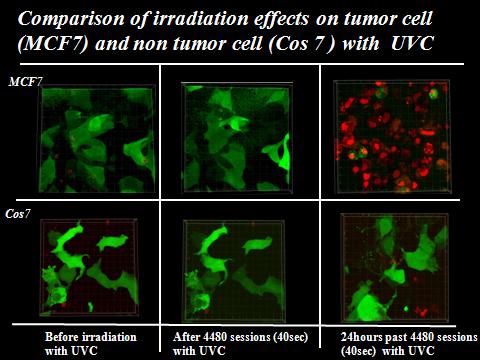Pulsed UVC irradiation selectively kills cancer cells
30 August 2012
A new and highly effective cancer therapy that irradiates cancer cells with ultraviolet C (UVC) light has been developed at the Tokai University School of Medicine in Japan.
The new method employs high intensity-UVC pulse flash rays (UVCPFR) of a broad UVC spectrum (230 to 280 nm) produced by a modified UV-flash sterilization system (BHX200).
The pulsed nature of the spectrum enhances the efficiency of destruction of neoplastic cells. Importantly, the research demonstrates that under the appropriate UVC irradiation conditions only neoplastic cell are destroyed, and non-neoplastic cells do not reach conditions of cell death.
Background, results, and implications
The well-known 'germicidal light' of low pressure mercury lamps (UV lamp) is widely used for sterilizing medical instruments. However, it takes several hours for the weak light from UV lamps to have their germicidal effects.
In contrast, the sterilization effects of UV pulsed flash rays (wavelengths of 230–280nm and peak wavelength of 248 nm) show promise as more efficient and rapid means of destroying a wider range of bacteria because this type of irradiation produces light whose energy is tens of thousands of times greater for a given area of irradiation, compared with conventional UV lamps (65W equivalency).
UVC pulse flash rays (UVCPFR) with 1–10 continuous flashes per second can be produced by powerful discharge of xenon gas. Johbu Itoh and colleagues at the Tokai University School of Medicine has developed and established UVCPFR therapy system for cancer therapy.

MCF7: neoplastic cell, COS7:non-neoplastic
cell. The Ultra Violet C (UVC) pulse flash irradiation only
selectivity caused death of neoplastic cells, and not non-neoplastic
cells.
The researchers irradiated cells with pulsed light UVCPFR and caused functional disorder to produce cell injury and/or a functional obstruction only to neoplastic cells. Higher ultraviolet radiation sensitivity in the UVC range was observed in neoplastic cells compared to non-neoplastic cells. That is, a short burst of ultraviolet radiation was sufficient to selectively induce injury and death to neoplastic cells.
Furthermore, experiments showed UVCPFR to cause cell death within a few seconds. One of the major features of this method is that below a certain range of irradiation conditions, damage to intact or non-neoplastic cells can be largely ignored, and only neoplastic cells die. This method offers a simple means of reducing the burden on patients undergoing cancer therapy.
Details of these findings were described by Johbu Itoh at the International Congress of Histochemistry and Cytochemistry (ICHC 2012) in Kyoto this week.
Itoh and colleagues plan to develop this system compatible for cancer treatment using endoscopy, laser microscopy, and other such light irradiation equipment.